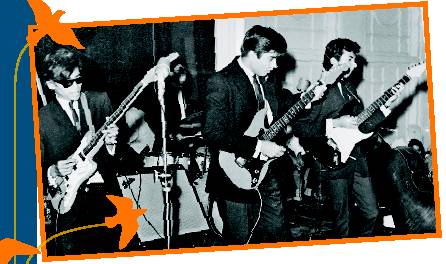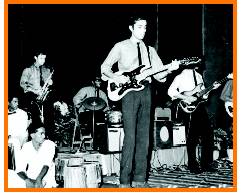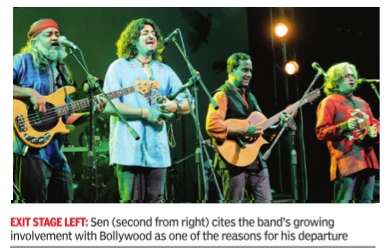Pop/ rock bands: India
You can send additional information, corrections and photographs on on their online archival encyclopædia only after its formal launch in late 2014 |
The times they were a-rockin’
India too had a beat generation back in the 1960s and ’70s, inspired by the rebellious mood in the West. To these bands goes the credit for pioneering India’s rock scene
Sidharth Bhatia
Contents |
The 1960s and ’70s: The context
The 1960s and ’70s were decades of great upheaval. World over, societies underwent massive change, moving away from conservatism to a more liberal order. Nuclear tension, the Vietnam War, women’s liberation, student riots — that period saw all this and more. And rock music. By the mid-’60s, the new generation, called the baby boomers, had begun to come of age and vociferously rejected everything their parents had believed in.
In India, the situation was similar, even if the concerns were far removed from those of the West. India’s first generation to be born after Independence, the so-called Midnight’s Children, entered their teens with no personal memory of the British Raj. India was not a rich country basking in post-war prosperity; it was poor and what is more, socialistic. This meant that it was, economically speaking, shut off from the rest of the world, in some ways literally. There were endemic shortages and government control. Ordinary consumer goods were not available. But the youngsters were not to be stopped. They were no less independent-minded than their counterparts in the rest of the world.
For me, this period in India’s history is fascinating. During those decades, we faced no less than three wars, saw the early stirrings of far-Left violence, begged around the world for food and suffered under Emergency. But there was also music. And in music lay a story.
The young urban Indian of the time looked westwards for ideas and was deeply inspired by the new sounds coming from there. Despite the fact that Indian radio, tightly controlled by the government, did not play western music, (and in the early years, even popular filmi music), young kids tuned to stations broadcasting on short wave. Radio Ceylon, BBC, Voice of America — radio dials were turned to these broadcasters and the music that wafted in was new. In many a home in Bombay, Bangalore, Calcutta, Madras, Delhi and elsewhere, the kids had heard jazz and singers like Frank Sinatra and Nat King Cole. They found this fuddy duddy. When the first Beatles single Love Me Do was released in October 1962, it struck a new chord with youngsters all over the world. Then came the Rolling Stones (and later, Led Zeppelin, Bob Dylan and Jimi Hendrix) and teenagers were entranced. They wanted to immediately pick up a guitar and start making music like that. But guitars were not easy to get — duties on imports of musical instrument were high.
So they went ahead and got local technicians to make guitars. For amps they used public address systems. Drums they got from local police bands. And when they found shops did not stock records of the latest music, they just banked on friends and cousins coming from abroad. Under these circumstances was India’s rock revolution born.
Scores, if not hundreds of music groups sprung up, playing cover versions and their own original music. They played wherever they could — in restaurants, concert halls, nightclubs, discos. They were paid niggardly amounts. Most were either still college students or had day jobs to make a living. Recording companies were not particularly interested in them, which is why there are so few LPs and singles from the time, and the rockers themselves wanted to stay away from the film business. Yet, they thrived and became hugely popular, and some of them became “brands” that are recalled even today. Names such as the Mustangs, the Savages, Human Bondage, the Combustibles, Brief Encounter, Great Bear and Atomic Forest have a resonance among those who grew up during the time and now are much older (though still rocking.)
Compared to Hindi cinema music, India’s rock scene, which lasted for over a decade, was small, confined to the westernized youth in the cities and on college campuses. But it is a metaphor for a certain spirit of independence and
freedom. Not only was the music new, but even social attitudes changed and the new Indian teenager — itself a product of the times — shed older values and attitudes.
Generation Gap became the mantra of the time. The long hair, the bellbottoms, the student marches – even, unfortunately, the drugs — were all symbolic of wanting to strike out on their own and be as different as possible from the previous generation. “Down with God, Country, Parents — Everything” was the headline of a cover story in the Illustrated Weekly of India about youth attitudes, with a photo of a rock band. The times, they were rocking. And rock music was the soundtrack of those psychedelic times.
Setting out to write about that generation, I found that most musicians and others I interviewed were modest about themselves and their bands. “We did what we did because we enjoyed it — nothing more,” was the common refrain. But there was unquestionably a little pride in having done it in very difficult circumstances, with obstacles that would be ridiculous today. (Turning a valve radio into an amp? A musician today would just laugh.) And the spirit is still there — in Vancouver, or New York or Goa or Calcutta, wherever they live (and tracking them down was not easy) many a musician of those times is still banging those drums and strumming that guitar and still belting out “Satisfaction” or “I want to hold your hand” or “Immigrant Song” at the top of his voice. Once a rocker, always a rocker.
BEAT B OYS
TROJANS
Probably the fi rst beat group to be formed in India. Four Bangalore boys get together, fashion their hair and clothes like those other four from Liverpool and strut their stuff in Bangalore, Calcutta and Bombay. One of them goes on to produce hit records in London—his name, Biddu.
MUSTANGS
Madras was abuzz with bands, the main competition being between students of Madras Christian College and Loyola. The Mustangs mainly played instrumental numbers and were among the early ones to cut a single. Their reunions draw a nostalgic crowd even today.
JETS
Bombay’s first band, which won so many fans that when it fi nally decided to break up, the farewell concert drew hundreds of fans. This group introduced the Fender Stratocaster to India, which changed their sound, even if three guitarists had to plug into one amplifi er.
[OF] HUMAN BONDAGE
Widely considered by their peers as the best and tightest rock group. They never cut a record, but their raga-infused performances all over the country, especially Delhi, where they played in popular discos like Cellars and Wheels, are still remembered.
GREAT BEAR/HIGH
Calcutta’s pride, a band that has a cult following till this day. Known not just for rock music but also originals, which included an opera based on Tolkien’s Lord of the Rings.
ATOMIC FOREST
Funk, Psychedelia and much more. Their one album Obsession 77 is a collector’s item and their troubled history has added more colour to their already formidable reputation.
This is a very brief list. It does not include groups like Raja Andrews and the Nawabs, who were said to be the first English-language pop group in India to cut a disc (with HMV). Biddu Appaiah, with his superhit Look out here I come /Daughter of darkness deserves an entire article for his music within India (not to mention his world-beating music from London). Then there were Indian hits like I married a female wrestler, Oh Yogi and Bombay meri hai (English), plus much by Usha (Sami/ Iyer/ Uthup). The film Bombay Talkie had two English language hits (Good Times… and Hari Om Tat Sat) by Shankar Jaikishan. Then there were Susmit Bose, Ajit Singh...
Readers can send additional information to the Facebook page, Indpaedia.com
2000s and 2010s
BAND BAGGAGE
Ruhi Batra
The Times of India Sep 21 2014
In his memoir, guitarist Susmit Sen speaks of the heartache and creative differences that drove a wedge into Indian Ocean. So how do successful bands stay together? Sunday Times finds out All bands eventually break up because of one or more of the four Ps: power, property, prestige, pussy,“ said metal legend Dave Mustaine in his autobiography, Mustaine: A Heavy Metal Memoir. The debauchery of Indian bands may not reach such wicked levels, but they have their share of creative rivalries, and easily bruised egos.
Indian Ocean
In 2013, Susmit Sen of Indian Ocean walked out of the band he helped put together in 1990, with the split sending shockwaves through fans. But it's only now that Sen has aired the reasons why he broke up with the band after 23 years. In his 2014 memoir Ocean to Ocean , he cites his dissatisfaction with the band's creative process and its growing involvement with Bollywood as the reason why he left to form a new outfit called the Susmit Sen Chronicles.
Parikrama
Parikrama, a fixture on the Indian rock scene, has been together for almost as long as Indian Ocean. It's not been without problems, admits keyboardist Subir Malik, who has seen members come and go. “But whatever differences we have on how a song should be made or played, we talk it out,“ says Malik. “We hear each other out, change what we need till we reach a consensus. And thankfully, most of the time we do.“
Demonic Resurrection
Sahil Makhija, frontman of the demonic metal band Demonic Resurrection (DR) that played at the prestigious death metal festival Wacken Open Air in Germany in 2104 , feels a band is “just like any relationship that needs compromise and understanding“.
Advaita
It's impossible for any band to escape disagreements. No matter how well you get along, there will be a chord progression which will just not sit right. According to Abhishek Mathur, guitarist with the decade-old band Advaita, it is not creative conflict that causes irreparable damage. “Creative differences can happen. Ego tussles -on who is getting the limelight -are worse, and it's sad when acts disband because of these issues.“
Some Indian bands have come to resemble revolving doors, with members coming and going. And no matter how often one has seen it happen, fans at least are never quite ready for it.
Avial
Avial, an alternative Malayalam rock band, caused quite a stir when it was formed in 2003. Formed by lead vocalist Anandraj Benjamin Paul, turntablist and backing vocalist Tony John, guitarist Rex Vijayan, bassist Naresh Kamath and drummer Mithun Puthanveetil, the single “Nada nada“ soon became their calling card. After numerous accolades for their debut album Avial in 2008, came the news that Paul and Kamath were quitting the band. John stepped in to take over vocal duties and the lungi wearing band has steadfastly held on to its following and has even composed music for Malayalam films. “It's never easy , and we've learnt it the hard way ,“ says Vijayan. “After the initial shock wears off -it's only human to feel that way -we realized that changes like these must not come in the way of our performance.“
For Makhija, losing the drummer is always the most worrying, and painful change.“Because of the kind of music DR plays, there's a limited talent pool to choose from. There just aren't enough guys who can drum that fast,“ he says.
Another common cause for conflict arises when bands share members. This usually leads to a clash in dates, especially in India where bands tour through the year. Mathur recalls the early days of Advaita when its members were a part of different setups and the group itself was a side-project. “It took a while for this core group to come together,“ he recalls. Suhail Yusuf Khan, who sings and plays the sarangi for the band, has another band, Adi & Suhail, and often has to carefully plan schedules.
But when push comes to shove, it's the bigger band that will trump the side-project. “I'm pretty ruthless. Parikrama has to be the number one priority but members may play where you like and with whosoever as long as it doesn't clash,“ says Malik.
Even if the dates don't, personalities will, with or without a Yoko in the picture.
Divine, Naezy
The Times of India, May 22 2016
Ruhi Batra
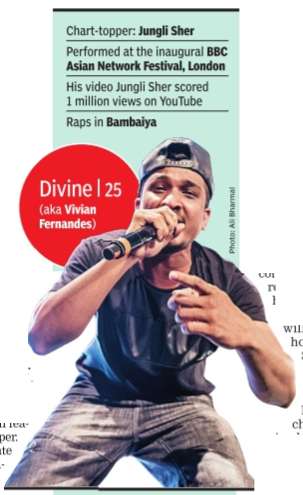
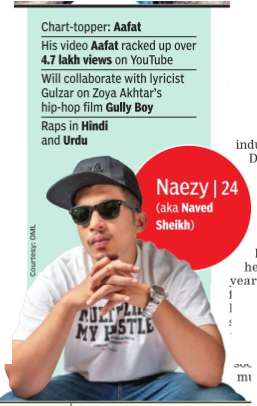
They were once boys from the `naka' rapping about their city from its chawls and gullies. Now, Divine and Naezy are stars with their songs about politics and poverty making waves at home and abroad
Divine aka Vivian Fer nandes once played `fill ers' at college shows.
Today, besides a major label contract, he has a viral video Jungli Sher with over a million views, and packed shows in London. The 25-year-old, who still lives in the slums of Andheri's JB Nagar, also made history as the first Indian rapper -he rapped freestyle in Hindi -for BBC 1 radio show host and rapper Charlie Sloth's iconic `Fire in the Booth' series.
Then there's Naved Sheikh, who at 13, was transformed by Sean Paul's Temperature when he first heard it spun by a DJ in his Kurla chawl. He went to a cybercafé the next day, printed out the lyrics and memorised them. In 2014 as a 22-year-old, Naved's alter-ego Naezy unleashed his frustration in a DIY video -Aafat -that was shot on D zero budget on an iPad. ( Aafat has since racked up F more than 4.7 lakh views on YouTube. It made Naezy the subject of the documentary Bombay 70 and got him a deal from Only Much Louder, India's biggest alternative culture promoter and management agency .His latest video, Haq Hai, has ratcheted over 30,000 views in just over a week.
These two rappers and their rap-to-riches stories are also the inspiration for Zoya Akhtar's next project, Gully Boy that (if whispers) are to be believed, will feature Ranveer Singh as a rapper.It will have Naezy collaborate on lyrics with poet and lyricist Gulzar.
Nothing confirms the entry of a subculture into the mainstream like a big Bollywood production. But how did these two young men, who rap in Bombaiya, tapori style, catch the nation's ears? The slums and chawls of Mumbai have always been a fertile ground for bhasha (language) rap, a style adapted from American rap but Indianised, that found a willing community online. But Naezy and Divine -who collaborated on the 2015 hit, Mere gully mein -told an authentic and original story that people have identified with all over the country .
“Mere gully mein represented the emergence of real, Indian hiphop. It echoed the same story that gave birth to hip-hop in New York -the story of the streets,“ says Tej Brar, a self-confessed hip-hop fiend and head of talent at OML.
Indians are familiar with rap and hip-hop. Songs like 50 Cents' It's ma birthday and Eminem's Slim Shady have been played on rotation in every coffee shop, club and birthday party while the current crop of Punjabi rappers have ensured that everyone can lip sync to at least one song about daaru, dope-shope and brown rang girls.
But Mere gully mein is different. The new-age desi rappers talk about corruption, lackadaisical governments, police brutality, family apathy, militancy and any issue that pushes them to speak out. (Divine compares Mumbai's citizenry to a herd of goats ready to be slaughtered by butcher-politicians). Quite a change from the kind of superficial, materialistic, aspirational hip-hop that surrounds us today .
“Delhi had a bustling Punjabi raphip-hop scene. But they made songs about cars, alcohol, girls. We rapped about our gully, our city . It was genuine, authentic Indian hiphop,“ says Divine, on a high after performing at the first-ever BBC Asian Network Festival at Eventim Apollo in London, which also featured popular singers like Kanika Kapoor and Badshah.
By speaking in a language that everyone from a roadside hawker to a rickshaw guy to a businessman would understand, and issues that affect everyone, these rappers became a window into the reality that is contemporary India.
“Hip-hop is modern-day protest music. Cleverly, through rhyme, you can speak your mind. That's the universal appeal. And the environment is ripe for it,“ says Cyrus Oshidar, managing director and creative director at 101india.
com, a youth content portal that recently released a 12-part hip hop documentary series called Hip-Hop Homeland. The series will next document the hip hop scenes in Punjab and Shillong.
Naezy, who recently released a song called Haq Hai, believes that hip-hop can be a gamechanger. “Hip-hop ek aisa zariya hai jo hamare desh main bhi badlav la sakta hai (hip-hop is a way to bring about a change in our country). The masses think that hip-hop is about daaru, nasha, bling and swag but if you really look at hip-hop's antecedents, it was used to bring about a revolution. I want to remove people's misconceptions and rewrite the history of Indian hip-hop,“ Naezy declares quite ambitiously .
Whether or not hip-hop brings about social change, the music industry is banking on its star, Divine, to rope in more talent and audiences. has Sony Music India, which signed on Divine, is con fident that hip-hop is a key space in India. “Rapping and hip-hop both have picked up considerably here over the last couple of years. Rappers like Bohemia founded the genre in India, Divine, on the other hand, is slowly taking raw and real rap to the mainstream audiences. We will be signing m o r e t a l e n t s o o n , “ s ay s Rohan Jha, lead pop music, Sony Music India.
